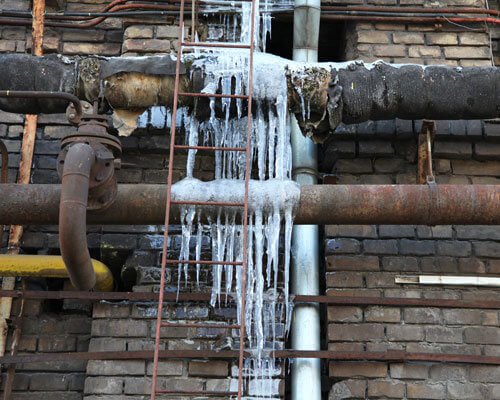Avoiding Frozen Plumbing in Cold Weather: Pro Advice
Avoiding Frozen Plumbing in Cold Weather: Pro Advice
Blog Article
This great article directly below involving Prevent Frozen Pipes is indeed engaging. Check it out for yourself and see what you think of it.

Cold weather can wreak havoc on your plumbing, particularly by freezing pipelines. Here's how to stop it from taking place and what to do if it does.
Intro
As temperature levels decline, the risk of frozen pipelines rises, potentially resulting in costly fixings and water damage. Comprehending just how to prevent icy pipelines is important for homeowners in chilly environments.
Recognizing Icy Pipes
What creates pipes to freeze?
Pipes ice up when exposed to temperatures below 32 ° F (0 ° C) for extended periods. As water inside the pipes freezes, it broadens, taxing the pipeline walls and possibly creating them to burst.
Threats and damages
Frozen pipelines can bring about water supply interruptions, residential property damage, and expensive repair services. Ruptured pipelines can flood homes and trigger comprehensive structural damages.
Indicators of Frozen Pipeline
Recognizing icy pipelines early can prevent them from breaking.
Just how to determine frozen pipelines
Look for reduced water circulation from taps, unusual smells or noises from pipelines, and noticeable frost on subjected pipes.
Avoidance Tips
Insulating prone pipes
Wrap pipes in insulation sleeves or utilize warmth tape to secure them from freezing temperature levels. Focus on pipes in unheated or external locations of the home.
Heating methods
Maintain indoor spaces appropriately heated, particularly areas with pipes. Open up closet doors to enable warm air to circulate around pipelines under sinks.
Safeguarding Exterior Pipes
Yard hoses and exterior faucets
Detach and drain yard pipes prior to winter. Mount frost-proof spigots or cover exterior taps with shielded caps.
What to Do If Your Pipes Freeze
Immediate activities to take
If you believe icy pipelines, keep faucets open up to ease stress as the ice thaws. Use a hairdryer or towels soaked in warm water to thaw pipes gradually.
Long-Term Solutions
Structural adjustments
Consider rerouting pipelines far from exterior walls or unheated areas. Add additional insulation to attics, basements, and crawl spaces.
Upgrading insulation
Purchase high-quality insulation for pipes, attic rooms, and walls. Proper insulation aids keep constant temperature levels and minimizes the danger of frozen pipelines.
Final thought
Stopping frozen pipes requires positive measures and quick feedbacks. By comprehending the causes, indicators, and safety nets, homeowners can safeguard their plumbing during winter.
6 Proven Ways to Prevent Frozen Pipes and Protect Your Home
Disconnect and Drain Garden Hoses
Before winter arrives, start by disconnecting your garden hoses and draining any remaining water. Close the shut-off valves that supply outdoor hose bibs and leave the outdoor faucet open to allow any residual water to drain. For extra protection, consider using faucet covers throughout the colder months. It’s also important to drain water from any sprinkler supply lines following the manufacturer’s directions.
Insulate Exposed Pipes
Insulating your pipes is an effective way to prevent freezing. Pipe insulation is readily available at home improvement stores and is relatively inexpensive. Pay close attention to pipes in unheated areas such as the attic, basement, crawl spaces, or garage. Apply foam insulation generously to create a buffer against the cold. You can also wrap your pipes in heat tape or thermostat-controlled heat cables for added warmth.
Seal Air Leaks
Inspect your home for any cracks or openings that could let in cold air. Seal any holes around the piping in interior or exterior walls, as well as the sill plates where your home rests on its foundation. Additionally, make sure to keep your garage door closed unless you’re entering or exiting. Leaving it open creates a significant air leak that can lead to frozen pipes.
Allow Warm Air Circulation
During cold snaps, it’s essential to allow warm air to circulate evenly throughout your home. Leave interior doors ajar to promote better airflow. Open kitchen and bathroom cabinets to help distribute heat consistently around the rooms. If you have small children or pets, be sure to remove any household chemicals or potentially harmful cleaners from open cabinets for safety.
Let Faucets Drip
A small trickle of water can make a big difference in preventing ice formation inside your pipes. When temperatures drop significantly, start a drip of water from all faucets served by exposed pipes. This continuous flow helps prevent the water from freezing. Additionally, running a few faucets slightly can relieve pressure inside the pipes, reducing the chances of a rupture if the water inside does freeze.
https://choateshvac.com/6-proven-ways-to-prevent-frozen-pipes-and-protect-your-home/

I am very fascinated by Winter Plumbing Precautions: Preventing Frozen Pipes and I am praying you appreciated my page. For those who liked our article kindly consider to pass it around. Bless you for being here. Come back soon.
Learn More Report this page